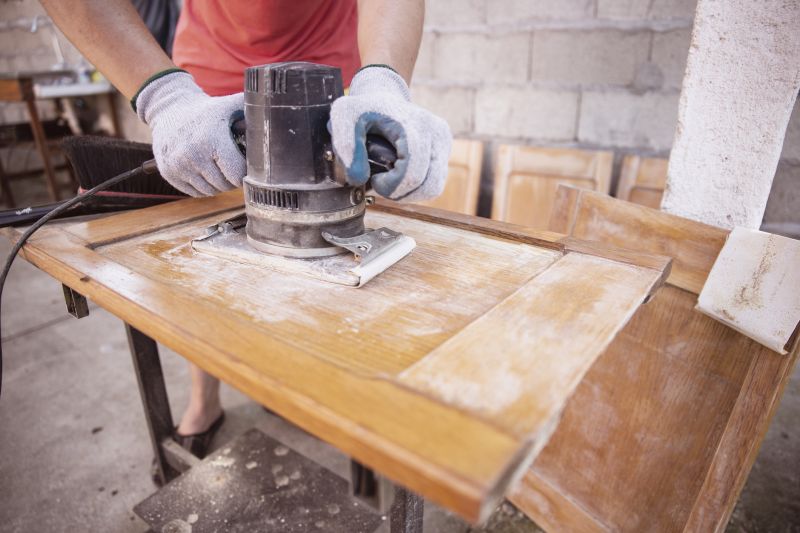Top Door Refinishings Products To Refresh Your Doors Quickly
Find essential tools and materials that simplify door refinishing, saving you time while delivering stunning results.
 Refinishing a door can significantly enhance the appearance of a space, providing a fresh and updated look without the need for complete replacement. The process often involves preparing the surface, choosing the right finish, and applying the appropriate products to achieve a smooth, durable, and aesthetically pleasing result. Whether restoring an antique door or updating a modern interior, the right selection of refinishing products is essential for achieving professional-looking outcomes.
Refinishing a door can significantly enhance the appearance of a space, providing a fresh and updated look without the need for complete replacement. The process often involves preparing the surface, choosing the right finish, and applying the appropriate products to achieve a smooth, durable, and aesthetically pleasing result. Whether restoring an antique door or updating a modern interior, the right selection of refinishing products is essential for achieving professional-looking outcomes.
Top Overall Option
Multi-Purpose Door Refinishing Kit
A comprehensive refinishing kit that includes primers, paints, stains, sealers, and application tools. Designed for versatility, it caters to various door materials and finishes, providing everything needed for a professional-looking result. Ideal for those seeking a complete solution that simplifies the refinishing process.
Types of Products For Door Refinishings
Wood Stain
Enhances the natural grain and color of wooden doors, available in various shades and finishes.
Paint Primer
Prepares surfaces for painting by sealing pores and creating a uniform base for the topcoat.
Interior Door Paint
Specially formulated for interior doors, offering durability and smooth finish.
Exterior Door Paint
Designed to withstand weather elements, providing protection and color for outdoor doors.
Clear Sealer
Adds a protective layer to seal and protect the refinished surface from scratches and moisture.
Sanding Sponge
Allows for smooth surface preparation and finishing between coats.
Paint Sprayer
Provides a quick and even application of paint or stain, ideal for large or detailed surfaces.
Brush Set
Includes various brush sizes for detailed work and touch-ups.
Roller Covers
Suitable for applying paint or primer smoothly over large flat surfaces.
Stripping Gel
Helps remove old paint or stain before refinishing.
Bonding Primer
Ensures better adhesion of paint or stain on challenging surfaces.
Oil-Based Stain
Provides rich color and penetrates deeply into wood surfaces.
Water-Based Stain
Offers easier cleanup and quick drying for door refinishing projects.
High-Gloss Finish
Creates a shiny, reflective surface that enhances the door's appearance.
Matte Finish
Provides a non-reflective, smooth surface ideal for a subtle look.
Polyurethane Topcoat
Offers durable protection against scratches and moisture.
Epoxy Resin
Creates a tough, glossy protective layer, suitable for high-traffic doors.
Popular Choices
A widely used option for updating indoor doors with a smooth, lasting finish.
Popular for restoring or enhancing natural wood appearances on doors.
Essential for preparing surfaces for a clean, even coat of paint.
Commonly used to protect painted or stained surfaces from damage.
Favored for quick, uniform application over large or detailed door surfaces.
Popular for achieving smooth finishes and preparing surfaces between coats.
Chosen for deep, rich color penetration in wooden doors.
Often selected for a subtle, non-reflective door surface.
Preferred for a shiny, polished look that highlights details.
Used for added durability and protection on painted or stained doors.
Commonly utilized to remove old finishes before refinishing.
Helpful for challenging surfaces to ensure adhesion of new finishes.
Popular for quick-drying, easy-to-clean staining options.
Selected for creating durable, high-gloss protective layers.
Frequently used for detailed application and touch-ups.
Commonly chosen for efficient coverage of large flat surfaces.
Popular for sealing and protecting painted or stained finishes.
A successful door refinish begins with surface preparation. This includes cleaning, sanding, and sometimes stripping old paint or stain to create a clean, even surface. After preparation, selecting the appropriate primer and paint or stain is crucial. The products used must be compatible and suitable for the door material, whether wood, metal, or composite. Finishing products such as sealers or topcoats help protect the surface from wear and environmental factors, extending the life of the refinished door.
Various tools and accessories are also vital for a quality refinish. These include brushes, rollers, sprayers, and sanding pads, each suited for different types of products and surfaces. Proper application techniques and drying times contribute to a smooth, even finish without drips or brush marks. Investing in quality products and tools can make the refinishing process more efficient and yield results that last for years.
Overall, door refinishing is a versatile project that can be tailored to different styles and preferences. With a wide array of products available, from primers and paints to stains and sealers, homeowners and professionals alike can find suitable options to achieve their desired look. Carefully selecting and applying these products ensures a durable, attractive finish that revitalizes any door and enhances the overall aesthetic of the space.
Key Buying Considerations
- Surface material compatibility to ensure proper adhesion and finish quality.
- Type of finish desired, such as matte, satin, or gloss, to match aesthetic preferences.
- Durability and protective qualities suitable for indoor or outdoor use.
- Ease of application, including tools required and drying times.
- Compatibility of primer, stain, and topcoat to prevent issues like peeling or uneven color.
- Environmental conditions, such as humidity and temperature, that can affect drying and curing.
- Level of surface preparation needed before applying refinishing products.
- Color options and whether the product can be tinted or customized.
- Coverage area to determine quantity needed for project scope.
- Brand reputation and product reviews for reliability and performance.
- Safety considerations, including VOC content and odor levels.
- Budget constraints and cost-effectiveness of product options.
- Availability of touch-up and maintenance products for future repairs.
- Resistance to scratches, moisture, and UV exposure if applicable.
- Compatibility with existing finishes or coatings on the door.
